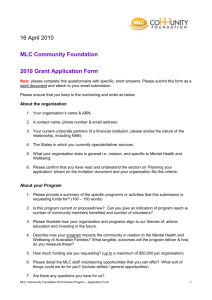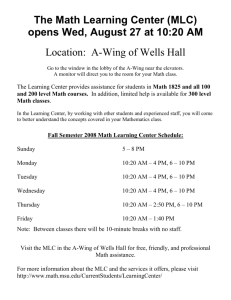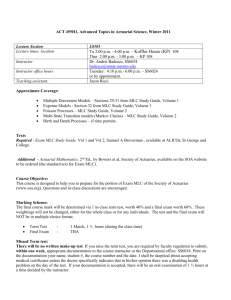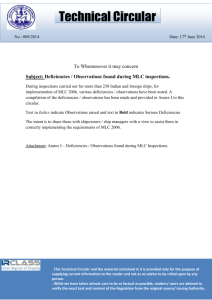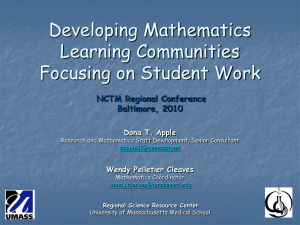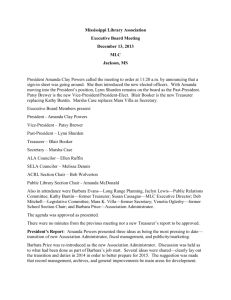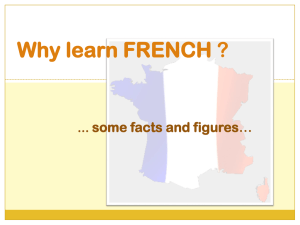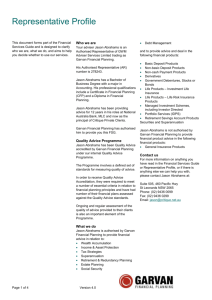MLC Population & Pedagogy
advertisement
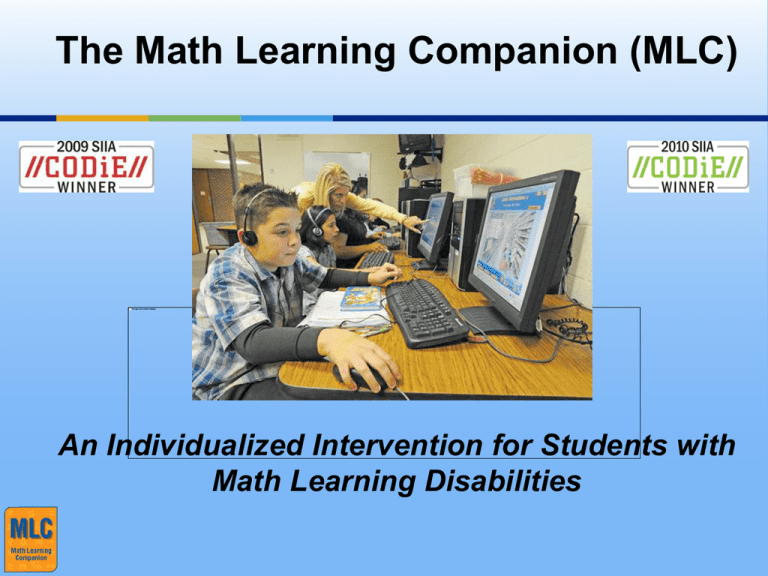
The Math Learning Companion (MLC) An Individualized Intervention for Students with Math Learning Disabilities Contents General Characteristics of Students with MLD and participants in MLC research study What works with Students with MLD MLC Pedagogy About Students with MLD Less understood than reading disabilities (RD) Not achieving in the general ed curriculum 5-8% prevalence Disability versus difficulty Persistent and sustained Cognitive not environmental No clear biological marker Weak math automaticity Co-occurrence with RD and ADHD MLC Research Students (2009-2010) Math Achievement Scores of Study Students Grade Level Equivalent 9.0 8.0 7.0 6.0 5.0 4.0 3.0 2.0 1.0 0.0 1 2 3 4 5 6 7 8 9 10 11 12 13 14 15 16 17 18 19 20 21 Broad Math GE 3.5 2.8 3.0 2.6 3.2 3.8 4.1 4.2 3.8 3.2 4.5 3.2 3.7 3.5 3.7 1.5 4.4 3.9 2.5 3.6 3.8 Brief Math GE 3.4 2.8 3.0 2.6 3.2 3.9 4.3 4.4 3.9 3.2 4.7 3.2 3.6 3.6 3.9 1.4 4.6 3.8 2.4 3.6 3.7 Math Calc GE 4.6 2.5 4.0 3.1 3.0 3.8 4.8 4.7 3.4 3.8 4.3 4.4 4.6 3.1 3.4 2.0 5.0 4.5 2.7 4.0 4.4 Applied Problems GE 2.5 3.2 2.2 2.2 3.5 3.9 3.5 3.7 4.4 2.7 4.6 2.2 2.8 3.9 4.1 0.0 3.7 3.3 2.3 3.3 3.3 Calculation GE 4.8 2.3 4.3 3.2 2.8 3.8 5.4 5.4 3.4 4.0 4.8 5.1 4.8 3.4 3.6 2.0 5.7 4.5 2.5 4.0 4.3 Math Fluency GE 4.0 3.1 2.9 2.6 3.6 3.6 3.3 3.1 3.2 2.9 3.1 2.6 4.0 2.4 2.9 2.0 3.4 4.3 3.6 3.5 4.5 Quantitative Concepts GE 4.7 3.0 3.4 3.4 5.3 4.3 3.9 4.3 3.7 3.6 2.6 2.6 4.3 4.3 4.3 0.0 2.3 5.0 2.3 2.5 3.7 Current Grade Level 6.6 6.6 6.6 6.6 6.6 6.6 6.6 6.6 6.9 6.9 6.9 6.9 6.9 6.9 6.9 7.9 7.9 7.9 7.9 7.9 7.9 MLC Research Students (2009-2010) MLC Research Students (2009-2010) About the Math Learning Companion Online intervention designed and developed specifically for students with Math Learning Disabilities Comprehensive math content & skills development Interwoven language support, with read-aloud and audio Full alignment to CCS, NCTM, TX, CO and other state standards, grades 3-8 Standards-based assessments; pre and post diagnostic placement assessments at each grade (hundreds of test items) Automatic placement and progression through curriculum Cognitively challenging with consistent feedback and review MLC Pedagogy Emphasizes critical foundations and prerequisite concept knowledge & skills Scaffolds the learning; makes math comprehensible without simplification Visual representation Synchronicity, visual contextual hints, modeling, guided practice, pacing, sequencing tasks and practice, etc. Focuses on vocabulary & development of academic language Breaks concepts into learning chunks Engaging and interactive: games, manipulatives, real world scenarios, with explicit connections between concrete and abstract Universal Design for Learning: adaptive & flexible Emphasis on Critical Foundations & Prior Knowledge (Gersten & Chard, 1999; Marzano, 2004; National Math Advisory Panel, 2008) • Provides embedded and active supports • Universal Design for Learning: adaptive & flexible • Breaks concepts into learning chunks (Miller, 1956) Visual Representation (Krashen, 1992, Gersten et al., 2009) • Read-aloud throughout • Synchronizing audio, visual, and text to create a visual connection between words, symbols, and meaning (e.g., corresponding vocabulary, symbols, or pictures flash in sync with audio). Scaffolding Math Concepts & Skills (Jitendra et al., 2005, Vygotsky, 1978) Emphasis on Critical Foundations and Number Sense In order to achieve higher levels of understanding foundational emphasis is on key math milestones, including rational numbers, fractions, decimals, ratios, and pivotal concepts in geometry and measurement (National Mathematics Advisory Panel, 2008). Students use a number line to help them visualize the operation. Number lines are an excellent tool for developing students’ number sense (Gersten et al. 2009). Scaffolding Math Concepts & Skills Reaching Grade Level Explicit Instruction & Modeling (Baker et al., 2002; Fuchs et al., 2008, Gersten et al., 2009) Emphasizes Language & Vocabulary (Marzano, 2004, Bull, 2007) Engaging Games & Manipulatives (Wright, 1996) Explicit Connections between Concrete & Abstract (Bull, 2007; Utall et al., 1997) Real World Scenarios Linking Prior Knowledge to Real Life (Lock, 1997) Systematic and Specific Instructional Feedback (Baker et al., 2002; Heward, 2009) Using Technology to Pinpoint: Diagnostic AssessmentPrescriptive Intervention 2. Which ratios are equivalent? A.7:2 and 2/7 B. 1/3 and 0.3 C. 2:4 and 4: 2 D. 2/3 and 0.6 [correct answer] Grade 6: (6.1) Number, operation, and quantitative reasoning. The student represents and uses rational numbers in a variety of equivalent forms. The student is expected to: (B) generate equivalent forms of rational numbers including whole numbers, fractions, and decimals Prescriptions: NMS Lesson: 11 (Working with Rational Numbers) – define sets of rational numbers; describe relationships between sets of rational numbers, including equivalency; compare and order rational numbers – whole numbers, integers, fractions, and decimals Math Foundations 3 Lesson: 4 (Number Line) – represent decimals on a number line; represent fractions and mixed numbers on a number line; represent positive and negative integers on a number line. Math Foundations 2 Lesson: 2 (Fractions & Decimals) – understand fractional equivalents using models; understand fraction and decimal equivalents Matching Student Need with Math Content SKILL MISSED: Number, operation, and quantitative reasoning. The student adds, subtracts, multiplies, and divides to solve problems and justify solutions. The student is expected to: use multiplication and division of whole numbers to solve problems including situations involving equivalent ratios and rates. BACKGROUND KNOWLEDGE MISSED: Math Foundations 1 Lesson: 4 (Division) - Dividing a multi-digit number evenly by a one-digit divisor Math Foundations 2 Lesson: 6 (Division) - Dividing multi-digit numbers by one-digit divisors using models (Hundreds Chart with Skip Counting, Arrays, and Checking Long Division with Multiplication) Math Foundations 3 Lesson: 6 (Division Skills) - Performing long division with multi-digit divisors, using long division in problem solving situations, and checking quotients with multiplication and models GRADE LEVEL LESSONS MISSED: Numbers Make Sense Lesson: 1 (Positive & Negative Numbers) Assign: Grade Level Lessons Assign all: Background and Grade Level MLC Features are Modifiable Diagnostic pretest and Individualized Student Pathway MLC features can be modified to fit individual student, group or class needs Custom lessons: including a library of favorites Custom lessons: search by topic, select particular sections Custom curriculum: order lessons, set mastery levels, present content from previous grades Arrange lesson to allow students to progress through content in a more linear or more constructive fashion Turn on/off active features: calculator, key terms, certain sections, translations Contact Information Lindy Crawford, Ph.D. Ann Jones Endowed Chair in Special Education Alice S. Neeley Special Education Institute College of Education Texas Christian University 817-257-4645 Barbara Freeman, Ed.D. MLC Managing Director 970-704-1017 barbarafreeman1@comcast.net
